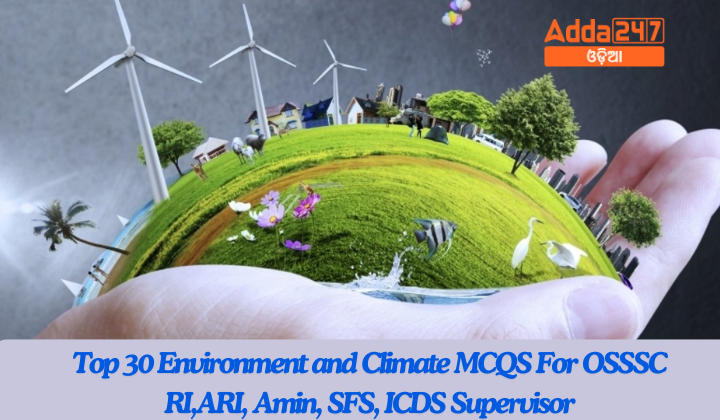Preparing for competitive exams like OSSSC RI, ARI, Amin, SFS, and ICDS Supervisor often requires a strong understanding of various subjects, including Environment and Climate. Here are 30 multiple-choice questions (MCQs) to help you prepare effectively.
Top 30 Environment and Climate MCQS For OSSSC RI,ARI, Amin, SFS, ICDS Supervisor
- Great Blue Hole is located in which country?
(a) The Bahamas
(b) Barbados
(c) Argentina
(d) Belize
Ans: (d) Belize - Which of the following statements about Primary producers are correct?
1. Primary producers are basically green plants.
2 They synthesize carbohydrates from simple inorganic raw materials.
3. Primary producers are absent in Aquatic Ecosystems.
(a) Only 1
(b) Only 1 & 2
(c) Only 2 & 3
(d) Only 3
Ans: (b) Only 1 & 2 - Which of the following is not a factor affecting climate?
(a) Distance from the sea
(b) Ocean currents
(c) Soil fertility
(d) Elevation
Ans: (c) Soil fertility - Which of the following factors contributes to the formation of local winds?
(a) Latitude
(b) Elevation
(c) Vegetation
(d) Ocean currents
Ans: (b) Elevation - Which of the following refers to the sum total of weather conditions and variations over a large area for a long period of time (more than thirty years).
(a) Weather
(b) Climate
(c) Season
(d) Temperature
Ans: (b) Climate - Due to the curvature of the earth, the amount of solar energy received varies according to ______________?
(a) Longitude
(b) Latitude
(c) Climatic Zones
(d) Altitude
Ans: (b) Latitude - Which is considered as the wettest place on the earth?
(a) Mawsynram
(b) Amazon
(c) Antarctica
(d) West Bengal
Ans: (a) Mawsynram - Which of the following statements are correct?
1.The pyramid of biomass may assume an inverted form in many aquatic ecosystems.
2.Producers in the aquatic ecosystems are tiny phytoplanktons that grow and reproduce rapidly.
3. The pyramid of biomass (inverted) has a small base, with the consumer biomass at any instant actually exceeding the producer biomass.
(a) Only 1 & 2
(b) Only 2 & 3
(c) Only 1 & 3
(d) 1, 2 & 3
Ans: (d) 1, 2 & 3 - The National Green Tribunal (NGT) was established in which year?
(a) 2008
(b) 2010
(c) 2012
(d) 2014
Ans: (b) 2010 - Who appoints the Chairperson of the National Green Tribunal (NGT)?
(a) President of India
(b) Prime Minister of India
(c) Chief Justice of India
(d) Central Government
Ans: (d) Central Government - Which of the following is not a renewable source of energy?
(a) Solar
(b) Wind
(c) Nuclear
(d) Hydropower
Ans: (c) Nuclear - Which of the following is a biotic component of the ecosystem?
(a) Temperature
(b) Light
(c) Soil
(d) Plants
Ans: (d) Plants - The ozone layer is found in which layer of the atmosphere?
(a) Troposphere
(b) Stratosphere
(c) Mesosphere
(d) Thermosphere
Ans: (b) Stratosphere - Which gas is primarily responsible for the greenhouse effect?
(a) Oxygen
(b) Nitrogen
(c) Carbon dioxide
(d) Hydrogen
Ans: (c) Carbon dioxide - What is the process by which plants lose water through their leaves?
(a) Photosynthesis
(b) Respiration
(c) Transpiration
(d) Evaporation
Ans: (c) Transpiration - Which of the following best describes an ecosystem?
(a) A group of organisms of the same species living in the same area
(b) The physical and biological components of an environment interacting
(c) A community of different species living together in an area
(d) The genetic variation within a population
Ans: (b) The physical and biological components of an environment interacting - Which of the following is an example of a primary consumer?
(a) Lion
(b) Hawk
(c) Grasshopper
(d) Mushroom
Ans: (c) Grasshopper - Which of the following is an abiotic factor in an ecosystem?
(a) Bacteria
(b) Fungi
(c) Temperature
(d) Plants
Ans: (c) Temperature - What term describes the maximum population size that an environment can support?
(a) Carrying capacity
(b) Limiting factor
(c) Ecological footprint
(d) Population density
Ans: (a) Carrying capacity - In which of the following biomes would you find the greatest biodiversity?
(a) Desert
(b) Tundra
(c) Tropical rainforest
(d) Grassland
Ans: (c) Tropical rainforest - Which of the following is not a method of soil conservation?
(a) Crop rotation
(b) Contour plowing
(c) Deforestation
(d) Terracing
Ans: (c) Deforestation - Which of the following is a nonrenewable resource?
(a) Solar energy
(b) Wind energy
(c) Coal
(d) Geothermal energy
Ans: (c) Coal - What is the main cause of soil erosion?
(a) Planting trees
(b) Water and wind
(c) Use of fertilizers
(d) Overgrazing by livestock
Ans: (b) Water and wind - Which type of pollution is caused by excessive nutrients in water bodies?
(a) Thermal pollution
(b) Radioactive pollution
(c) Eutrophication
(d) Noise pollution
Ans: (c) Eutrophication - Which of the following is the most significant contributor to acid rain?
(a) Carbon dioxide
(b) Sulfur dioxide
(c) Methane
(d) Ozone
Ans: (b) Sulfur dioxide - Which gas is produced by the decomposition of organic matter in the absence of oxygen?
(a) Methane
(b) Nitrogen
(c) Oxygen
(d) Argon
Ans: (a) Methane - What is the primary cause of deforestation in the Amazon rainforest?
(a) Urbanization
(b) Agriculture
(c) Mining
(d) Road construction
Ans: (b) Agriculture - Which of the following is a factor influencing the distribution of vegetation and wildlife in India?
(a) Temperature
(b) Altitude
(c) Rainfall
(d) All of the above
Ans: (d) All of the above - The climate of the northeastern states of India is influenced by:
(a) Bay of Bengal
(b) Arabian Sea
(c) Indian Ocean
(d) Himalayan mountains
Ans: (d) Himalayan mountains - highest annual range of temperature is found in which type of climate?
(a) Tropical rainforest
(b) Desert
(c) Mediterranean
(d) Steppe
Ans: (b) Desert





